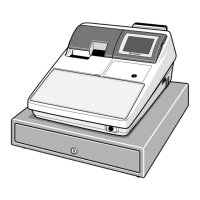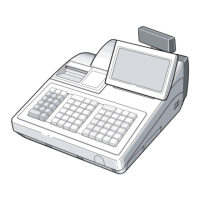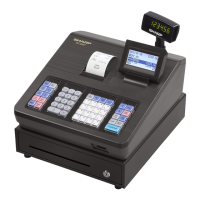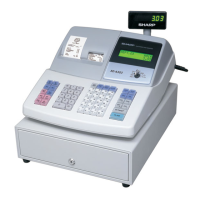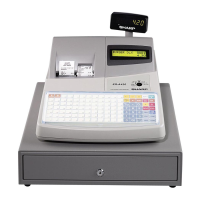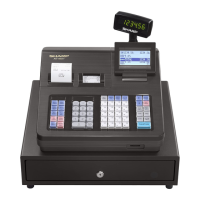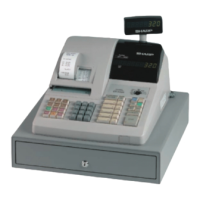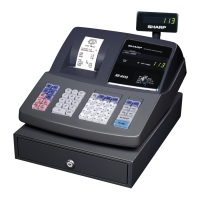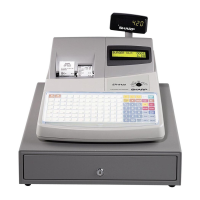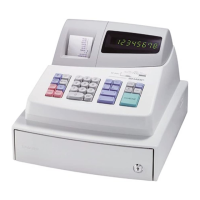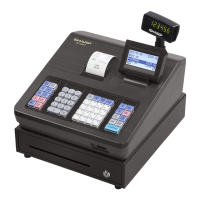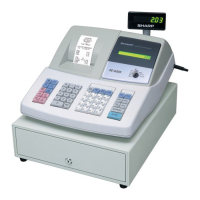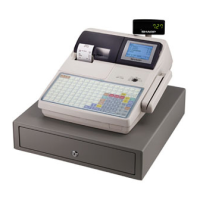
Do you have a question about the Sharp UP-600 and is the answer not in the manual?
| Brand | Sharp |
|---|---|
| Model | UP-600 |
| Category | Cash Register |
| Language | English |
Provides critical safety guidelines and usage recommendations for the POS terminal.
Details important precautions for operating and maintaining the POS terminal.
Instructions for the proper disposal of the Nickel Metal Hydride battery.
Details the external components and views, including front, rear, printer, and keyboard.
Explains the function of mode switches, lock keys, and other operational controls.
Describes the operator and customer displays, including screen save mode.
Covers initial steps like display adjustment and time settings before first use.
Details preparations for entries, error warnings, and sample receipt formats.
Covers server code entry, various single item entry methods, and repeat entries.
Explains multiplication, split-pricing, successive multiplication, and scale entries.
Details SICS, age verification, PLU/UPC linking, mix-and-match, and combo meals.
Covers various tender methods including cash, check, charge, and mixed tenders.
Details food stamp tendering, tax calculations, guest check systems, and deposits.
Covers percent calculations, discounts, refunds, returns, and non-add codes.
Details tip entries, editing, paid tips, currency conversion, and account entries.
Covers paid-out entries, no-sale function, check cashing, and customer management.
Explains the WASTE mode for disposing of unserviceable articles.
Details direct void for last entry and indirect void for earlier entries.
Explains subtotal void and correction of entries not handled by direct/indirect void.
Covers printing message text, copy receipts, validation slips, and server times.
Explains using MGR mode for managerial decisions and overriding limits.
Details voiding incorrect entries found after finalizing a transaction using MGR mode.
Instructions for taking X1/Z1, X2/Z2 reports and flash reports for sales data.
Provides transaction, department, and group reports for daily sales analysis.
Covers PLU/UPC reports by range/department, stock, and server performance.
Details consolidated periodic reports and customer sales analysis.
Deletes non-accessed UPCs and customers, with options for reports and individual deletion.
Clears dynamic UPC data by range, pick up codes, or associated department.
Illustrates the keyboard layout for programming operations in PGM 1 or PGM 2 mode.
Details methods for programming characters, including character keys and editing.
Explains entering characters using numerical codes via the '00' key.
Covers basic instructions, department, PLU/UPC, dynamic UPC, and stock programming.
Details linking PLUs, condiments, mix & match, combo meals, and functional keys.
Programs media keys (cash, check, charge) and custom text for functions and messages.
Configures server details, terminal settings, and system date/time.
Selects optional features, prohibits functions, and programs secret codes for security.
Programs report settings and manages data like UPC deletion and downloads.
Details transactable UPC-A, UPC-E, EAN-8, EAN-13 codes and their entry requirements.
Explains add-on codes and managing UPC main and dynamic files.
Guides on recovering from power failures and resolving printer errors.
Details paper roll installation/removal, jam clearing, and ink ribbon replacement.
Explains how to remove the till and drawer, and operate the drawer manually.
Provides troubleshooting checks for common issues like display, receipt, and printing problems.
Lists optional hardware for the POS terminal, like memory boards and readers.
Details dimensions, weight, power, temperature, and electronics specifications.
Provides specifications for the printer, ink ribbon, and paper rolls.
Lists cash drawer details and included accessories.
